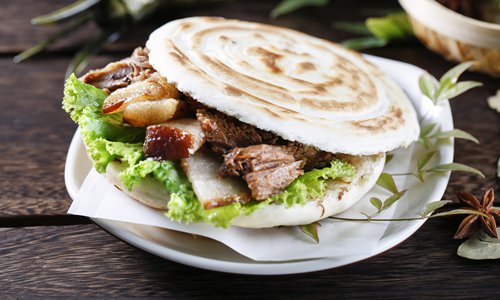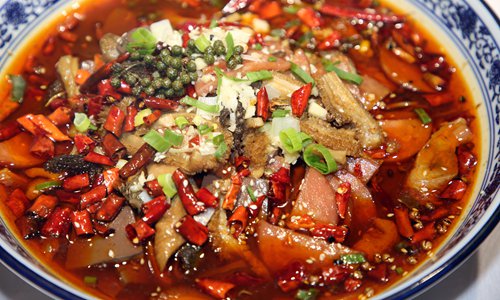Increasing number of overseas Chinese restaurants using pinyin for dish names
By Bi Mengying Source:Global Times Published: 2019/10/17 18:18:40

Customers pick ingredients for spicy maocai soup at a restaurant in China. Photo: IC

Roujiamo - flatbread-like bun with stuffing Photo: IC

The spicy Chinese soup known as malatang Photo: IC
Dishes such as spring rolls and sweet and sour chicken may be familiar to many lovers of Chinese food in English-speaking countries, but what about dishes such as chun bing or knife noodles?
Translating the names of dishes has always been somewhat of a challenging task for restaurant owners outside of China.
Take Junzi Kitchen, a Chinese fast-casual restaurant chain in the US was established by a group of Yale-educated entrepreneurs from China, for instance.
"In Chinese philosophy, a junzi is a person with integrity. Being a junzi is a pursuit: It means to be honest, kind, open to new ideas, and above all, the best version of ourselves," writes the restaurant chain's official website.
Junzi is often translated to "gentleman" in English, yet the English word is not fully capable of portraying the complete meaning of the original Chinese and all its connotations. Similarly, finding the right translation for certain Chinese dishes can also prove difficult. So much so that Junzi Kitchen has decided that it is much easier to use the Chinese pinyin for some dishes or a literal translation in some cases for its menu.
When it comes to "Squash and grain salad" and "smashed cucumbers," the name says it all, but for chun bing and knife noodles, the restaurant has added a small explanation so hungry customers know what they are getting if they decide to give these dishes a try.
"Chun bing is a northern Chinese thin flour-pressed dough," while the entry for knife noodles says they "are wide, wavy, rippled noodles with a variety of textures and thickness."
Entering the lexicon
Obviously, Junzi Kitchen is not the first to attempt to introduce Chinese food to English-speakers. Buwei Yang Chao did so in her book How to Cook and Eat in Chinese, first published in 1945. US culinary historian Anne Mendelson described the work as "the first truly insightful English-language Chinese cookbook."
The book has a foreword by the well-known writer Hu Shi, also a former ambassador to the US, and a preface by Pearl Buck, a US author famous for her expertise on the subject of China. In the foreword, Hu spoke highly of the creativity in the language the book uses to describe certain Chinese cooking methods, such as defisher, stir-fry, meeting and plunging. It is through this book that the word stir-fry entered the English lexicon and became a common word in the US.
In her book, the author noted that the original Chinese word chao "cannot be accurately translated into English. Roughly speaking, ch'ao may be defined as a big-fire-shallow-fat-continual-stirring-quick-frying of cut-up material with wet seasoning. So we shall call it stir-fry."
The Oxford English Dictionary included the noun form of "stir-fry" in its new word list in June 2015. Subsequently, the adjective and verb forms were also added to the dictionary. In addition to stir-fry, other words originated from the book such as soy jam, red-cooking, pot sticker, dim sum and yuan hsiao.
Cultural confidence
As more Chinese dishes from various regions throughout China enter the US, the challenge of translating and introducing them has increased. Take Xi'an Famous Food for instance, a restaurant chain that has expanded multiple branches across New York City from its original location in Flushing in 2005. The widely-popular store brands itself as "the first restaurant to bring the little-known cuisine of Xi'an to the United States."
The family-owned business hopes to introduce the world to the unique cuisine of their hometown of Xi'an in Northwest China such as liangpi, roujiamo and biangbiang mian - all in their most authentic forms.
For liangpi, they used a literal translation from the Chinese coming up "cold-skin noodles." "Chewy wheat flour noodles, tossed with bean sprouts, cucumbers, cilantro and cubes of spongy gluten," the chain's website further notes in its description of the dish. For roujiamo, this is called a "burger" and described as a warm and crispy flatbread-like bun packed with different stuffing. As for biangbiang mian, it is listed as wide, hand-ripped noodles.
Malangtang is another point in case. Rather than a fancy dish, this is a type of street food that derived from Southwest China's hot pot, but adapted to cater to the taste buds of northerners. Meanwhile, there is also maocai, which is rather similar to malatang but keeps its southwestern spicy flavor. The difference between the two still baffles many who live in China, so some people might wonder how it should be translated into English when it enters the US market.
Laoma Spicy, a malatang restaurant franchise headquartered in Flushing, New York has decided to forgo translating the name and just call the spicy soup dish malatang.
"Mala (spicy in Chinese) is flavor, many restaurants are using the word in their names now. Some Chinese companies maybe lack cultural confidence, so they end up doing a bad job of translating the many great names [of our food]," Liu Tuo, owner of Laoma Spicy, told the Global Times.
Laoma Spicy also serves another spicy Chinese dish mala xiangguo, which usually contains meat and vegetables and is often translated as "dry hot pot" at some restaurants.
"We translated it as mala wok, because xiangguo [fragrant pot] is hard to pronounce [for non-Chinese speakers]. And wok is the term for a Chinese black iron pot. I think it's more appropriate to translate it this way."
When asked whether the names malatang or mala wok might turn away those who cannot figure out what type of dish it is from the names, Liu responded, "There's no need to worry about that. Before we tried taco or pizza for the first time, we probably didn't know much about them, either."
Newspaper headline: On the menu
Posted in: FOOD,CULTURE & LEISURE